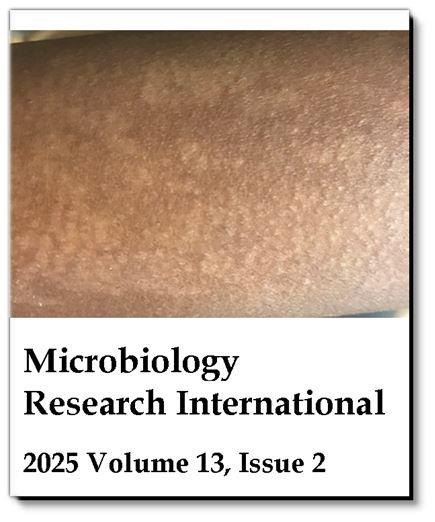Demographic survey and bacterial skin profile of patients and staff of a teaching hospital in Port Harcourt, Nigeria
J. Z. Keziah, T. Sampson and B. S. BaranuMicrobiology Research International
Published: April 7 2025
Volume 13, Issue 2
Pages 40-46
Abstract
The skin microbiota is a diverse ecosystem of microorganisms that serve as a crucial defense against pathogenic invasion. In healthcare settings, such as teaching hospitals, both patients and healthcare workers (HCWs) harbor unique bacterial skin flora influenced by various demographic and clinical factors. This study, therefore, focused on the demographic survey and bacteriological skin profile of patients and healthcare workers at a teaching hospital in Port Harcourt, Nigeria. Skin swab samples were collected from 69 patients and hospital staff using sterile swab sticks and transported aseptically to the Microbiology Laboratory, Department of Microbiology, Faculty of Science, Rivers State University, Port Harcourt, Nigeria. Socio-demographic data revealed that hospital staff comprised a higher percentage (63.77%) than patients (36.23%). Individuals aged 21–30 years had the highest representation (47.82%), while those under 20 years had the lowest (5.76%) among the assessed staff and patients. The study identified a variety of bacterial skin flora, including Bacillus species, Escherichia coli, Micrococcus species, Klebsiella species, Staphylococcus aureus, and Staphylococcus epidermidis. S. aureus had the highest prevalence (33.33%) among patients and staff, while Micrococcus and Klebsiella species had the lowest occurrence (5%). Laboratory staff exhibited the highest prevalence of Staphylococcus species (11.59%) and Bacillus species (30%). E. coli was detected in 13.79% of patients in the female medical ward. Findings from this study highlight the significant role of hospital personnel in the epidemiology of hospital-acquired infections and underscore the need for more effective infection control measures in healthcare facilities. Klebsiella.
Keywords: Bacterial skin flora, demography, healthcare workers, patients, teaching hospital.
Full Text PDF
